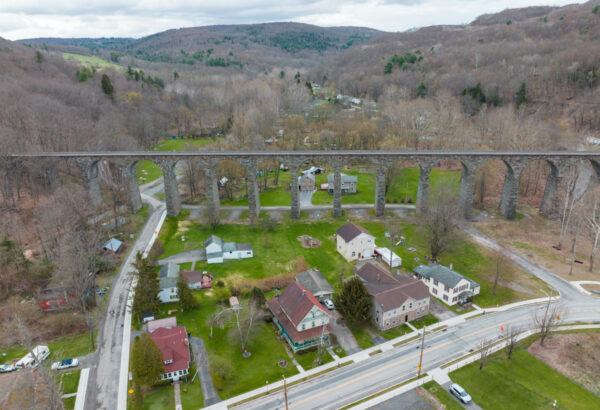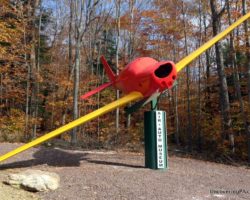In the mid-1800s, the railroad industry in Pennsylvania was huge business.
Throughout the state, engineers continually came up with ingenious and often record-breaking ways to get trains across the many mountains and valleys throughout the landscape. During this time, spots like the Allegheny Portage Railroad, Horseshoe Curve, and the Kinzua Viaduct were built to improve the speed and efficiency of train travel in Pennsylvania.

In the northeastern corner of Pennsylvania, the railroads operating throughout the region also had mountains to overcome.
In the mid-1840s, the New York and Erie Railroad was attempting to cross this corner of the state on its route from New York City to Lake Erie in Dunkirk, New York. However, they had a problem with the wide Starrucca Creek Valley, which was less than three miles from the New York border in Susquehanna County, Pennsylvania.
After considering different options, it was decided to cross the valley via a stone arch viaduct. It took a year of construction and 800 workers to complete the viaduct, which opened in 1848.

When it was completed the Starrucca Viaduct was 1,040 feet long and had 17 arches. It reached heights as much as 100 feet above the valley floor below.
At its completion, it was the world’s largest stone railway viaduct. It is also thought to have been the world’s most expensive railroad bridge ever built and the first use of structural concrete in an American bridge.

Other than being expanded from one track to two in 1886 and portions of it being reinforced with concrete in the 1950s, the Starrucca Viaduct looks much the same today as it did when it was completed more than 170 years ago.
Interestingly, while it’s not as well known today as the nearby Tunkhannock Viaduct, one can assume the Starrucca Viaduct was an inspiration for this other famous railroad bridge as the Starrucca Viaduct was completed more than 60 years before that structure.

The bridge and its track are currently owned by the New York, Susquehanna, and Western Railroad. They run regular cargo trains between New York City and Binghamton, New York that pass over the viaduct. Unfortunately, at this time, there is no passenger service that passes over this historic viaduct.
Under the large bridge is the small community of Lanesboro, PA. The houses here are located directly underneath the bridge and it really gives a great sense of scale to see them next to the viaduct.

While there are several places you can view the viaduct from, the best spot is the small Luciana Park.
To reach the park, from North Main Street in Lanesboro, turn onto Depot Street (you can only turn one way onto this street). Pass underneath one of the viaduct’s arches, and immediately look for a very narrow dirt road branching off to the right just as Depot Street begins to climb uphill.
This short road ends in a dirt parking area with some picnic tables and a nice view of the Starrucca Viaduct. When I visited in October 2019, the road was pretty heavily rutted, but I had no issues getting to the area with a standard car. Just make sure to use caution while driving on this road.

Luciana Park can be found at the following coordinates: 41.965491, -75.582639.
This park consists of nothing more than a couple of picnic tables and an informational sign about the viaduct but provides some of the best views of the bridge. Make sure to take the short walk back up the road to where Depot Street crosses under the viaduct to enjoy the great views from directly underneath this massive structure.

While old paintings and photos indicate that there used to be better viewing areas for the viaduct when the area was clear cut, the area around the park provides the best views in the 21st century.
Of course, you can also see the bridge from other spots, though parking is difficult and some aren’t really safe places to stop a car. Despite this, take a few minutes to drive around the area, especially along North Main Street, and enjoy the views of this incredible piece of engineering from your car.

While the Starrucca Viaduct might not be worth an overly long drive to see for the casual visitor, it’s a great spot for railfans and history buffs to check out and to see what was, at one time, one of the most impressive engineering feats in Pennsylvania.
It’s worth noting, for those that are looking to visit the area, the Starrucca Viaduct is located about 15 minutes away from the town of Starrucca, PA, so make sure you enter the right place in your GPS when checking it out.
Looking for more places to visit nearby? Check out the Susquehanna County Historical Society Museum, Salt Springs State Park, and Tanners Falls.
[Click here for information on how to use coordinates to find your destination.]




 "
"




Thank you featuring the Starrucca Viaduct. After all I only minutes away from it in the town of Susquehanna. It’s a small & old railroad which is slowly rebuilding.
If you’re interested down the road (Route #171) is the towns of Thompson & further down is Forest City & then Simpson. Each with their own histories.
Again Cathy Yoder
Thank you much for this lovely memory. My first home was nearly under the Viaduct, right next to the creek (sadly that home was destroyed to build the new bridge). As a teen, we’d often sneak up to walk across the Viaduct. That location is very much a part of all Susquehannock’s lives.
My grandpa’s home was also located very close to the viaduct so that the backyard went up to one of the piers. It was also next to the creek, on the northside. A 2nd-3rd cousin and family was living in the house when it was destroyed by fire about 10 years ago. Many fond memories.
William Least Heat-Moon has a beautiful essay titled “Starrucca Viaduct.” I am visiting because of it.
I had planned for some time to visit the viaduct and your article gave me the impetus to do so. Great writeup and photos! And yes, the viaduct is magnificent! There is also hiking or biking along the adjacent D&H Rail Trail. Maybe you want to update the article to mention that. Thanks!
Glad you had a great visit!